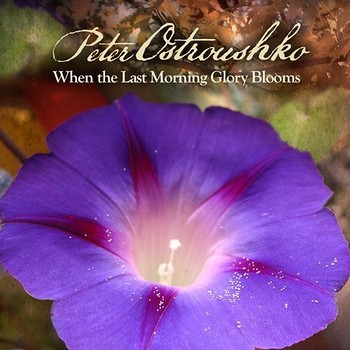
[purchase]
If there is one type of song that says love, it is the waltz. Two people in love take to the floor, hold each other close, and move together in a beautiful harmony. For them, the rest of the world does not exist while the song plays. They are in their own world. Peter Ostroushko understands this, and provides the scenery for that world.
I hope I may be forgiven for the romanticism of that opening. When the Last Morning Glory Blooms is almost entirely an album of waltzes, and this is very romantic music. What comes through most clearly is the love that Ostroushko feels for the people he wrote the songs for. Sometimes these are the musicians he has befriended over the years. Two of the songs, The B and B Waltz and The A and A Waltz, were written for friends’ weddings, and are as much about their love for each other as Ostroushko’s feelings for them as friends. And the most exciting piece on the album is Marjorie’s Waltz # 4; Marjorie is Ostroushko’s wife, and, on this evidence, she is a lucky woman.
Peter Ostroushko first came to my attention years ago when he appeared semi-regularly on A Prairie Home Companion. He is best known as a mandolin player, but he switches to fiddle for two songs here. On most of the songs, the other featured instrument is the piano. Sometimes there is a cello or a string quartet, and Marjorie’s Waltz # 4 even has an accordion. The rhythm section, when there is any, is a stand-up bass and possibly an acoustic guitar. And there is only one song that is not in 3/4 time. So there really isn’t a lot of variation in the possible arrangements, and there are no words to focus on; this is an instrumental album. This could be a very dull album. But Peter Ostroushko and his accompanists are very fine musicians, so the emotions in the playing keep this one interesting. Also, Ostroushko explores just how much can be done with the waltz form, so I was right there with him the whole time.
Ostroushko has assembled a fine band here. Norman and Nancy Blake play on one song, The Nine Years Waltz. Texas legend Johnny Gimble joins Ostroushko for a fiddle duet on Memories of Tyler, Texas. But the rest of the songs sound just as good; when Ostroushko plays with the regular band here, there is no drop off in the quality of the playing. The piano playing of Dan Chouinard and Robert Dworskey is particularly notable; they each get a creamy tone that contrasts beautifully with the percussive sound of Ostroushko’s mandolin. This is particularly important because Ostroushko is a generous bandleader; he drops out of a song for a while, and lets his accompanists have a turn. The best example of this generosity is Waltz for Sedra. Ostroushko wrote this one to order for 16 year old fiddle prodigy Sedra Bistodeau, who asked for lots of double-stops. Ostroushko says that he fully intended to add a harmony part, but when he heard the recording so far, he felt that Bistodeau’s performance needed no further embellishment. So here is a song that Peter Ostroushko does not even play on, on his own album!
Ostroushko does a wonderful job of exploring different kinds of love in his writing. The wedding waltzes portray a love that has blossomed from that first rush into something deeper and more lasting. Some of the songs portray the love of a place, whether real or fictional, reveling in the serenity of a beautiful scene. And Marjorie’s Waltz # 4 conveys the exhilaration that is still possible in the love of two people growing older together. I started by saying that the waltz is the song of love. On When the Last Morning Glory Blooms, Peter Ostroushko explains.
Peter Ostroushko: The B and B Waltz
Peter Ostroushko: Marjorie‘s Waltz # 4






1 comments:
Wow, the B & B is gorgeous. Thanks for this - a real treat.
Post a Comment